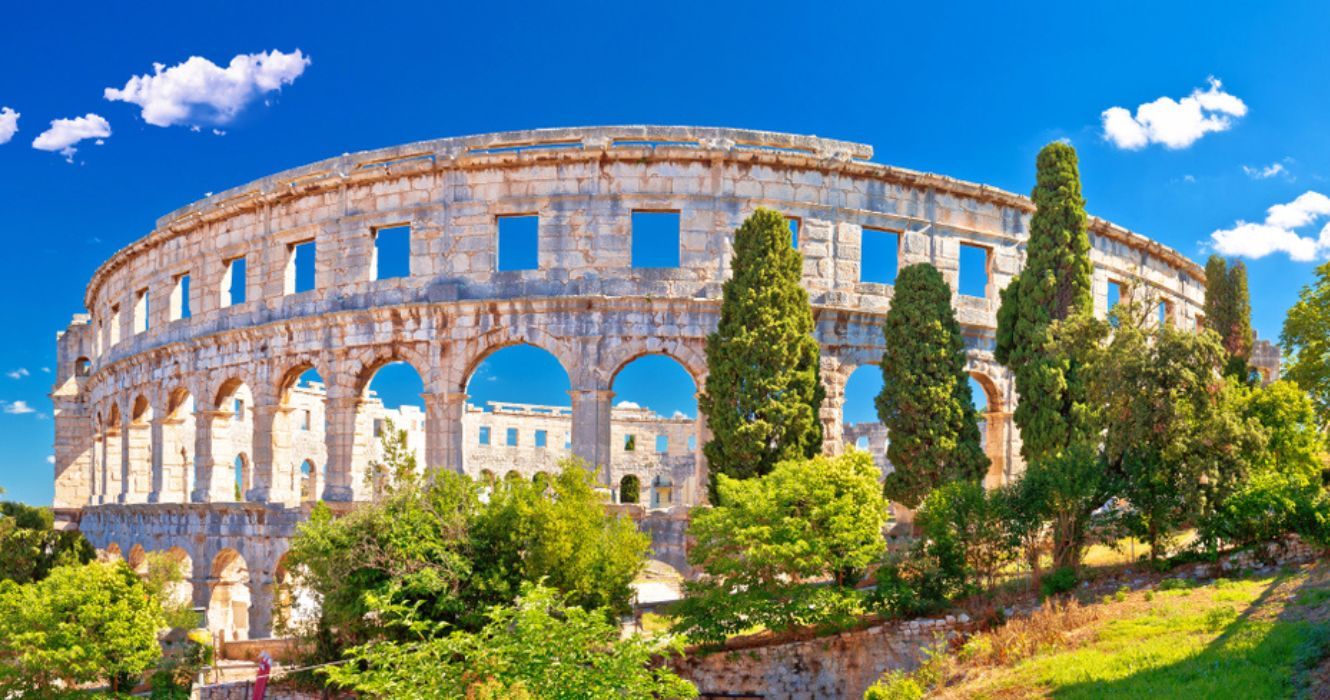Roman roads. Roman laws. Roman virtue. Of all the civilizations that have had an influence on the world, few can compare to the Roman civilization for its enduring legacy right up to the 21st century. We still read of Julius Caesar, and enjoy the philosophies, intrigues, and drama—surrounding such figures as Marcus Aurelius, Mark Anthony, and Cleopatra. Even in the shaping of the American Republic, Rome (and perhaps Greece) was the founders’ guiding light.
It could be the reason Rome, for many years, has been one of the most popular cities for American travelers.
One of the vestiges of the Roman Empire is the Colosseum, an almost 2,000-year-old amphitheater bathed with both glory and scandal in equal measure. However, the Colosseum is not in good shape. Over two-thirds of it is gone, and modern repairs have changed its well-known facade. Unknown to many, there’s a Roman amphitheater in Croatia that’s the best preserved in the world.
What To Know About Pula Arena In Croatia—Rome’s Best Preserved Amphitheater
No, the Colosseum is not the only Roman amphitheater. There came a time in Rome’s architectural history—when there arose in the heart of the republic’s rulers, a spirit of infatuation with amphitheaters.
The effect is that over 200 amphitheaters rose up all across the empire, some as far away as Phoenicia in present-day Libya. Most of these amphitheaters have gone into ruin; unhappy victims of time and tide.
However, on Croatian soil, a Roman amphitheater still proudly stands, the best preserved of those cultural and architectural marvels. And that is the Pula Arena.
We might imagine that others crumbled because they were enormous and therefore more prone to the elements. However, of all the Roman amphitheaters still standing, the Pula Arena is the sixth in size—eloquently refuting the argument of size.
While all the remaining Roman amphitheaters have a side tower or two missing, Pula Arena still retains all its four towers by its sides.
Even among all the ancient monuments in the Balkan state, including those not traced to the Roman period, Pula Arena still comes out as the best preserved. As a testament to Croatians' pride in the historic building, Pula Arena appears on Croatian Kuna, as the currency of the country is known.
Fascinating History Of The Pula Arena, Croatia
While accounts vary in their detail, most historians place the construction of the Pula Arena before that of the Roman Colosseum which was itself built from AD 70 to AD 72.
Augustus, the successor of Caesar who led the evolution of Rome from a republic to an empire, is credited with initiating the construction of the building. However, credit for its architectural finesse and eventual completion goes to Vespasian, several years later.
In the first century, the city we now call Pula went by the name Pietàs Julia. The name Julia actually belongs to Augustus’ daughter, who, after the father had razed the city for siding with Brutus in the wake of Caesar's murder, reportedly pled with the father to rebuild the city.
At completion, the structure’s four towers had wooden staircases inside them which climbed up to the top rows of the amphitheater—as well as to a water reservoir that lay at the top. The reservoir would harvest rainwater that flowed to a fountain which in turn would sprinkle scented water on the spectators to cool them.
As with the Colosseum, the Pula Arena was the theater of vicious gladiatorial fights where those in the dominion of Rome would merrily while away the time. This continued until about the 7th century, long after the sun of the eternal city had dipped low in the west.
Here’s How The Pula Arena Looks Like Today
Since the 1930s, the Pula Arena has been the scene of various public functions including concerts, military ceremonies, and, surprisingly, hockey games. This is after it underwent significant repairs and restorations in the 19th century.
The Pula Film Festival, arguably the most famous film festival in Croatia, takes place at the Pula Arena. This festival comes to town every summer.
Today, the seating capacity of the amphitheater is about 7,000, while about 12,500 can stand within its somber walls.
- How Much Is The Admission Fee To The Pula Arena? The admission fee to the Pula Arena starts at about $10.50 per adult.
The structure has four floors and stretches to a height of 32.5 meters(about 106 feet). On a visit, one can be shown the chambers where both slaves and animals would be kept.
Also on display are wine-making materials that are many decades old as well as related presses.
Being right in the middle of the city, and not as crowded as the Colosseum, this amphitheater is a fine place to live in the faded shadow of Roman culture and a defining centerpiece of its norms and mores.

